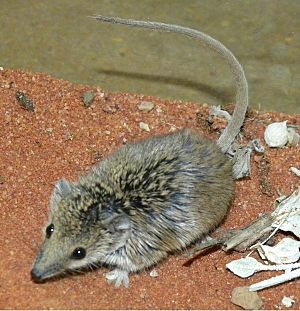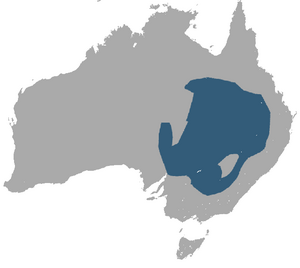Narrow-nosed planigale facts for kids
Quick facts for kids Narrow-nosed planigale |
|
|---|---|
 |
|
| Conservation status | |
| Scientific classification | |
| Genus: |
Planigale
|
| Species: |
tenuirostris
|
 |
|
| Narrow-nosed planigale range | |
The narrow-nosed planigale (Planigale tenuirostris) is a tiny marsupial animal. It's a type of carnivore, meaning it eats meat, and belongs to the Dasyuridae family. Think of it as a very small, flat-headed hunter!
Contents
Understanding the Narrow-Nosed Planigale
How Scientists Name Them
A scientist named Ellis Le Geyt Troughton first described the narrow-nosed planigale in 1928. He realized it was different from the common planigale (P. maculata). The scientific name, Planigale tenuirostris, actually means "slender-snouted flat-weasel." This name perfectly describes its unique features.
What Does a Planigale Look Like?
Planigales are very small, almost like tiny rodents. They are usually no bigger than 7.5 centimeters (about 3 inches) long. They weigh less than 10 grams, which is super light! The narrow-nosed planigale has a reddish-brown color. It is also smaller than most other planigales. Only the long-tailed planigale is tinier.
A Fearless Hunter
This little animal is a very active hunter. It bravely chases after many different invertebrates, which are creatures without backbones. It's known for being a fearless and strong predator. Its flat head helps it push apart grass stems. It also uses its head to flip over leaves in the leaf litter. This helps it find hidden prey. Sometimes, it even attacks prey that is bigger than itself!
Life and Habits of the Narrow-Nosed Planigale
What Do They Eat?
Narrow-nosed planigales are generalist insectivores. This means they eat many kinds of insects and other small creatures. Their diet changes based on what food is available in their environment. They mostly eat arthropods, like beetles, centipedes, and spiders. Sometimes, they might even eat small lizards.
Where Do They Live?
These planigales prefer open areas with less dense plants. You can often find them in grassy fields and low shrubland. They especially like places with cracking clay soils. These soil cracks provide perfect hiding spots and homes for them. Research also shows that they are more common where plants are taller.
Daily Behaviour and Activity
Unlike some other planigale species, the narrow-nosed planigale is active only at night. This is true in both summer and winter. They spend only short periods being active. Studies have shown they might be active for about 1 hour and 25 minutes in summer. In winter, this active time can increase to about 2 hours and 56 minutes. They come out of the soil cracks to hunt at night. During the day, or when not hunting, they stay inside these cracks, clinging to the vertical sides.
Life Cycle and Reproduction
The breeding season for narrow-nosed planigales runs from July to mid-January. This time matches when food is most available, usually in spring and summer.
- Female Planigales: Females have 12 teats and a pouch, like other marsupials. They can start having babies when they are about 240 days old. Females are only ready to mate for one day, and this happens every 33 days.
- Male Planigales: In males, the process of making sperm starts in July. It usually finishes the following March.
- Gestation and Young: The mother carries her babies for only about 19 days. The young stay attached to the teats for about a month after birth. Mothers start to wean their young (stop feeding them milk) when they are about three months old.
- Litters: In zoos, females can have two litters of babies each year. They usually have about six young in each litter. However, in the wild, they usually only have one litter per year.
Challenges for Survival
The number of narrow-nosed planigales can change from year to year. But overall, this species seems to be doing well. There are no major widespread threats to them.
Loss of Habitat
One local problem for planigales is when their habitat is changed or destroyed. This often happens when land is cleared for farming. This can cause their populations to decrease in specific areas.
Staying Safe from Predators
Because they live below ground and hunt within soil cracks, narrow-nosed planigales are quite safe. This protects them from most larger animals that might try to hunt them.
Impact of Rainfall Changes
Some research suggests that changes in rainfall might affect planigale populations. This includes the narrow-nosed planigale. However, more studies are needed to confirm this. Scientists want to know if it's just the rain itself or how rain affects their food sources.
Where Do They Live?
The narrow-nosed planigale can be found in several parts of Australia. These include New South Wales, Queensland, South Australia, and the Northern Territory. They live in many different inland habitats. They especially like areas with cracked clay soil.
See also
 In Spanish: Planigalo de hocico estrecho para niños
In Spanish: Planigalo de hocico estrecho para niños


